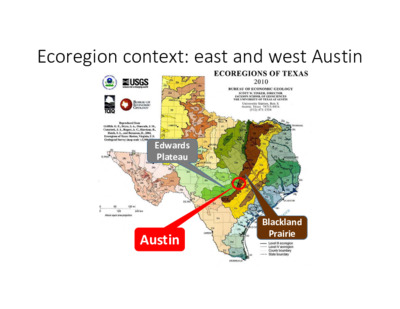20201007-002b: Briefing on Riparian Protection — original pdf
Backup

Ecoregion context: east and west Austin Edwards Plateau Austin Blackland Prairie Social context: east and west Austin http://projects.statesman.com/news/economic‐mobility/ Lake Austin, Barton Creek, and Williamson Creek Watershed Ordinances Comprehensive Watersheds Ordinance Drainage Criteria Manual Floodplain Ordinance Waterway Ordinance 1974 1977 1980 1981 1983 1986 1991 1992 1997/98 2001 2012 2013 2015 2019 Urban Watersheds Ordinance Watershed Protection Ordinance Land Development Code Revision Atlas 14 floodplain ordinance Save Our Springs Ordinance Lower Watershed ordinance What is a Riparian Area? Soil Water Vegetation Soil Water Vegetation Why protecting and restoring creeksides? community‐centric Urban Heat Island mitigation Access to nature to explore, learn, relax, breath Greenbelt connectivity Air quality Shade Why protecting and restoring creeksides? system‐focus Summarize watershed health Higher moisture and tree survival than uplands Wildlife habitat corridors Natural networks Healthy creeksides, healthier creeks (water quality and quantity, erosion protection) Why restoring creeksides? community and resiliency In tending to nature, can we heal? Is the resiliency in creeksides a story that speaks to us as communities? Existing protections Gaps Critical Water Quality Zones Floodplain Modification Provisons Substantial development restrictions in floodplains No restoration triggered when CWQZ or creek are in poor condition (except when floodplain modification) Current stormwater management allows bypassing of creek